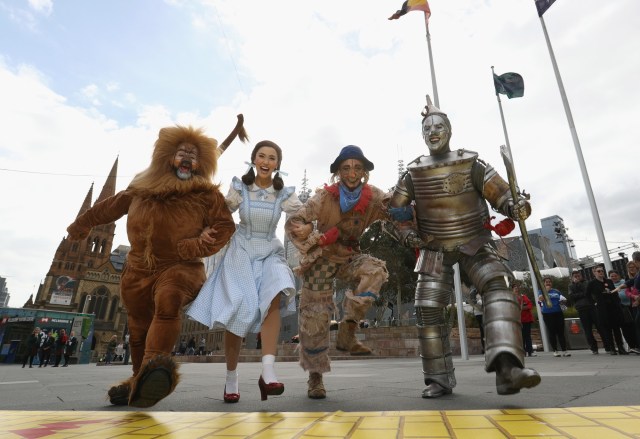Credit: Robert Cianflone / Getty

When I was a child, The Wizard of Oz was a running joke – a tired old Hollywood classic that the BBC would put on the telly every Christmas.
It’s even older now – closer in time to the end of the American Civil War than it is to the present day. However, its reputation has grown. If a nation as young as America can be said to have a mythos, then The Wizard of Oz is an integral part of it.
As with most cultural icons, the 1939 film (and the earlier novel it was adapted from) is open to political interpretations. Only this week, Bidisha offered a few of her own in the Guardian:
“The US of The Wizard of Oz is not so far from the US of today. The supposedly great man living in Trump Tower – I mean Emerald City – turns out to be a con artist, a bloviating coward who relies on self-aggrandisement and empty shows of power to cow the people.”
This provoked a bit of a backlash on Twitter. The gist of the rather patronising criticism aimed at her was that she’d read far too much into what was ‘only’ a story.
However, you don’t have to share Bidisha’s contemporary interpretations – “we can read the catastrophic effects of climate change into the tornado that sets the narrative off, see the opioid crisis in the characters’ drugged sleep in Oz’s Powell and Pressburger-esque poppy field…” – to see that the story is heaving with symbolic elements. It was surely written with some kind of allegorical purpose.
If so, what was Frank Baum, the author of the original novel (The Wonderful Wizard of Oz) allegorising back in 1900?
The most compelling theory (as set out by Henry Littlefield in 1964) is that the story symbolises the American politics of in the late 19th century – a time when the Populist Party was challenging the duopoly of the Democrats and Republicans.
The Populists aimed to forge an alliance between the poor farmers of the West and South and the industrial working class of the North East – as symbolised in the story by the Scarecrow and the Tin Man. The Cowardly Lion was said to represent William Jennings Bryan, an accomplished orator who would take up the populist cause, but also prove instrumental in merging most of the movement into the Democratic Party.
The great dividing issue of the era was over monetary policy. The Populists wanted the currency to be backed by gold and silver (the policy of free silver or bimetallism) not gold alone. The aim was to expand the money supply and lower interest rates – to the advantage of the debt-burdened farmers of the West and disadvantage of the financial establishment on the East Coast.
Therefore the Yellow Brick Road of the story symbolised the gold standard, while Dorothy’s slippers (originally silver, not ruby) symbolised the cause of monetary reform.
The Yellow Brick Road led to the centre of power – the Emerald City (green symbolising the Dollar). Of course, when Dorothy and her companions get to the city they discover that their supposed saviour, the titular wizard, is a powerless fraud.
With headlines about the failure of Donald Trump (and Justin Trudeau) to stop GM from shutting down five factories in North America, the symbolism of the story seems as relevant as ever. As Bidisha puts it, “the central reveal about the hollowness, cynicism, opportunism, egotism and fakery of our leaders is chillingly apt”.
As for monetary policy, the gold standard has long been abandoned, but other economic decisions, made behind the curtain in the Emerald Cities of our own world, have also produced undeserving winners and losers: those who benefit from artificially-inflated asset values versus the victims of debt-fuelled consumerism.
As in the Populist Era of the late 19th Century, the economic and social divisions of the New Populist Era are also geographical: flyover country versus the global cities – the places that the Yellow Brick Road leads away from versus the places it leads to.
In the film, Dorothy eventually escapes the Technicolor land of Oz to return to the monochrome realities of Kansas. Bidisha laments that our heroine “goes from wishing to explore all the shades of the rainbow to gratefully embracing black and white”. However, not everyone gets to have that choice.
Populists such as Donald Trump succeed by recognising that for millions of Americans there really is ‘no place like home’, indeed no place but home. Even if he fails to do anything to improve his supporters’ lives, at least he doesn’t disparage them (if only because he’s too busy insulting everyone else).
Populism will not be defeated until mainstream politics – and culture – finds a way of according dignity, granting agency and restoring hope to every part of society.










Join the discussion
Join like minded readers that support our journalism by becoming a paid subscriber
To join the discussion in the comments, become a paid subscriber.
Join like minded readers that support our journalism, read unlimited articles and enjoy other subscriber-only benefits.
Subscribe